Experimental Investigation of Runback Water Flow Behavior on Aero-Engine Rotating Spinners with Different Wettabilities
Abstract
:1. Introduction
2. Experimental Setup
2.1. Rotating Spinner Model
2.2. Surface Treatment
2.3. Straight-Flow Spray Wind Tunnel and Phase-Locked Observation Technology
2.4. Experimental Conditions
3. Results and Discussions
3.1. Flow Patterns of Runback Water on the Stationary Spinner
3.2. Flow Patterns of Runback Water on the Rotating Spinner
3.3. Effect of Rotational Speed on the Flow Path and Velocity of Runback Water
3.4. Effect of Wettability on the Flow Behavior of Runback Water on the Rotating Spinner
4. Conclusions
- (1)
- On stationary spinners, continuous water films form on superhydrophilic surfaces, while no water adhesion is observed on the superhydrophobic surface.
- (2)
- On rotating spinners, rivulet flows start to appear on hydrophilic and hydrophobic surfaces. Increased rotational speeds lead to finer and more numerous rivulet flows. These rivulet flow paths exhibit circumferential deflection due to centrifugal and aerodynamic drag forces. The deflection angle primarily depends on the magnitude and direction of the resultant velocity. Additionally, the square of the rivulet flow velocity is proportional to the rotational speed.
- (3)
- Surface wettability affects runback water flow behavior in two ways. In the flow direction, an increase in contact angle leads to higher flow velocities, with runback water more likely to form rivulet and bead-like flows. In the normal direction, an increased contact angle allows centrifugal force to overcome surface adhesion more easily, promoting the detachment of runback water.
Author Contributions
Funding
Data Availability Statement
Conflicts of Interest
References
- Mason, J.; Strapp, W.; Chow, P. The Ice Particle Threat to Engines in Flight. In Proceedings of the 44th AIAA Aerospace Sciences Meeting and Exhibit, Reno, Nevada, 9–12 January 2006; American Institute of Aeronautics and Astronautics: Reston, VA, USA, 2012. [Google Scholar]
- Venkataramani, K.; McVey, L.; Holm, R.; Montgomery, K. Inclement Weather Considerations for Aircraft Engines. In Proceedings of the 45th AIAA Aerospace Sciences Meeting and Exhibit, Reno, Nevada, 8–11 January 2007; American Institute of Aeronautics and Astronautics: Reston, VA, USA, 2012. [Google Scholar]
- McVey, O.; Pullen, R. Inclement Weather and Aircraft Engine Icing. In Proceedings of the SAE Aircraft Engine Icing Conference and Exhibition, Seville, Spain, 24–27 September 2007. [Google Scholar]
- Veres, J.P.; Jorgenson, P.C. Modeling Commercial Turbofan Engine Icing Risk with Ice Crystal Ingestion. In Proceedings of the 5th AIAA Atmospheric and Space Environments Conference, San Diego, CA, USA, 24–27 June 2013; American Institute of Aeronautics and Astronautics: Reston, VA, USA, 2013. [Google Scholar]
- Graversen, P. Grand Based Measuring and Warning of Weather Conditions in Which Engine Icing May Occur. In Proceedings of the SAE Aircraft Engine Icing Conference and Exhibition, Seville, Spain, 24–27 September 2007. [Google Scholar]
- Belz, R.; Brasier, C.; Murphy, P.; Davis, T. A Turbine Engine Inlet Viewing System. In Proceedings of the 22nd Joint Propulsion Conference, Huntsville, AL, USA, 16–18 June 1986; American Institute of Aeronautics and Astronautics: Reston, VA, USA, 2012. [Google Scholar]
- Antonov, A.N.; Aksyonov, N.K.; Goryachev, A.V.; Chivanov, S.V. Fundamentals of Calculation, Design and Testing of Anti-Icing Systems of Aviation Gas Turbine Engines; Antonov, A.N., Ed.; Central Institute of Aviation Motors: Moscow, Russia, 2001; ISBN 978-5-94049-003-6. [Google Scholar]
- Chen, N.; Ji, H.; Hu, Y.; Wang, J.; Cao, G. Experimental Study of Icing Accretion on a Rotating Conical Spinner. Heat Mass Transf. 2015, 51, 1717–1729. [Google Scholar] [CrossRef]
- Hu, Y.; Xu, C.; Li, S.; Li, P.; Liu, L. Experimental Study on Icing and Anti-Icing of a Rotating Conical Spinner. Appl. Therm. Eng. 2023, 219, 119373. [Google Scholar] [CrossRef]
- Messinger, B.L. Equilibrium Temperature of an Unheated Icing Surface as a Function of Air Speed. J. Aeronaut. Sci. 1953, 20, 29–42. [Google Scholar] [CrossRef]
- Myers, T.G.; Thompson, C.P. Modeling the Flow of Water on Aircraft in Icing Conditions. AIAA J. 1998, 36, 1010–1013. [Google Scholar] [CrossRef]
- Bourgault, Y.; Beaugendre, H.; Habashi, W.G. Development of a Shallow-Water Icing Model in FENSAP-ICE. J. Aircr. 2000, 37, 640–646. [Google Scholar] [CrossRef]
- Myers, T.G. Extension to the Messinger Model for Aircraft Icing. AIAA J. 2001, 39, 211–218. [Google Scholar] [CrossRef]
- Myers, T.G.; Charpin, J.P.F. A Mathematical Model for Atmospheric Ice Accretion and Water Flow on a Cold Surface. Int. J. Heat Mass Transf. 2004, 47, 5483–5500. [Google Scholar] [CrossRef]
- Wang, Z.; Zhu, C. Study of the Effect of Centrifugal Force on Rotor Blade Icing Process. Int. J. Aerosp. Eng. 2017, 2017, 8695170. [Google Scholar] [CrossRef]
- Chen, X.; Zhao, Q. Numerical Simulations for Ice Accretion on Rotors Using New Three-Dimensional Icing Model. J. Aircr. 2017, 54, 1428–1442. [Google Scholar] [CrossRef]
- Chen, N.; Ji, H.; Cao, G.; Hu, Y. A Three-Dimensional Mathematical Model for Simulating Ice Accretion on Helicopter Rotors. Phys. Fluids 2018, 30, 083602. [Google Scholar] [CrossRef]
- Wang, Z.; Zhu, C. Numerical Simulation of Three-Dimensional Rotor Icing in Hovering Flight. Proc. Inst. Mech. Eng. Part G J. Aerosp. Eng. 2018, 232, 545–555. [Google Scholar] [CrossRef]
- Su, F.; Yao, K. Facile Fabrication of Superhydrophobic Surface with Excellent Mechanical Abrasion and Corrosion Resistance on Copper Substrate by a Novel Method. ACS Appl. Mater. Interfaces 2014, 6, 8762–8770. [Google Scholar] [CrossRef] [PubMed]
- Liu, Y.; Li, S.; Zhang, J.; Liu, J.; Han, Z.; Ren, L. Corrosion Inhibition of Biomimetic Super-Hydrophobic Electrodeposition Coatings on Copper Substrate. Corros. Sci. 2015, 94, 190–196. [Google Scholar] [CrossRef]
- Yu, S.Q.; Ling, Y.H.; Wang, R.G.; Zhang, J.; Qin, F.; Zhang, Z.J. Constructing Superhydrophobic WO3@TiO2 Nanoflake Surface beyond Amorphous Alloy against Electrochemical Corrosion on Iron Steel. Appl. Surf. Sci. 2018, 436, 527–535. [Google Scholar] [CrossRef]
- Wang, B.; Liu, H.; Chen, C.; Zhang, H.; Du, C.; Zhou, L. Novel Fabrication of Superamphiphobic Molybdenum Oxide Coatings by Chemical Deposition. Mater. Lett. 2019, 249, 116–119. [Google Scholar] [CrossRef]
- Feng, L.; Zhang, Z.; Mai, Z.; Ma, Y.; Liu, B.; Jiang, L.; Zhu, D. A Super-Hydrophobic and Super-Oleophilic Coating Mesh Film for the Separation of Oil and Water. Angew. Chem. Int. Ed. 2004, 43, 2012–2014. [Google Scholar] [CrossRef] [PubMed]
- Wu, W.; Wang, X.; Liu, X.; Zhou, F. Spray-Coated Fluorine-Free Superhydrophobic Coatings with Easy Repairability and Applicability. ACS Appl. Mater. Interfaces 2009, 1, 1656–1661. [Google Scholar] [CrossRef] [PubMed]
- Hikita, M.; Tanaka, K.; Nakamura, T.; Kajiyama, T.; Takahara, A. Super-Liquid-Repellent Surfaces Prepared by Colloidal Silica Nanoparticles Covered with Fluoroalkyl Groups. Langmuir 2005, 21, 7299–7302. [Google Scholar] [CrossRef] [PubMed]
- Shang, H.M.; Wang, Y.; Limmer, S.J.; Chou, T.P.; Takahashi, K.; Cao, G.Z. Optically Transparent Superhydrophobic Silica-Based Films. Thin Solid Film. 2005, 472, 37–43. [Google Scholar] [CrossRef]
- Wang, S.; Feng, L.; Jiang, L. One-Step Solution-Immersion Process for the Fabrication of Stable Bionic Superhydrophobic Surfaces. Adv. Mater. 2006, 18, 767–770. [Google Scholar] [CrossRef]
- Ta, D.V.; Dunn, A.; Wasley, T.J.; Kay, R.W.; Stringer, J.; Smith, P.J.; Connaughton, C.; Shephard, J.D. Nanosecond Laser Textured Superhydrophobic Metallic Surfaces and Their Chemical Sensing Applications. Appl. Surf. Sci. 2015, 357, 248–254. [Google Scholar] [CrossRef]
- Pan, Q.; Cao, Y.; Xue, W.; Zhu, D.; Liu, W. Picosecond Laser-Textured Stainless Steel Superhydrophobic Surface with an Antibacterial Adhesion Property. Langmuir 2019, 35, 11414–11421. [Google Scholar] [CrossRef] [PubMed]
- Sun, M.; Luo, C.; Xu, L.; Ji, H.; Ouyang, Q.; Yu, D.; Chen, Y. Artificial Lotus Leaf by Nanocasting. Langmuir 2005, 21, 8978–8981. [Google Scholar] [CrossRef] [PubMed]
- Cho, W.K.; Choi, I.S. Fabrication of Hairy Polymeric Films Inspired by Geckos: Wetting and High Adhesion Properties. Adv. Funct. Mater. 2008, 18, 1089–1096. [Google Scholar] [CrossRef]
- Hong, S.-H.; Hwang, J.; Lee, H. Replication of Cicada Wing’s Nano-Patterns by Hot Embossing and UV Nanoimprinting. Nanotechnology 2009, 20, 385303. [Google Scholar] [CrossRef] [PubMed]
- Deng, T.; Varanasi, K.K.; Hsu, M.; Bhate, N.; Keimel, C.; Stein, J.; Blohm, M. Nonwetting of Impinging Droplets on Textured Surfaces. Appl. Phys. Lett. 2009, 94, 133109. [Google Scholar] [CrossRef]
- Liu, Y.; Moevius, L.; Xu, X.; Qian, T.; Yeomans, J.M.; Wang, Z. Pancake Bouncing on Superhydrophobic Surfaces. Nat. Phys. 2014, 10, 515–519. [Google Scholar] [CrossRef] [PubMed]
- Guo, P.; Zheng, Y.; Wen, M.; Song, C.; Lin, Y.; Jiang, L. Icephobic/Anti-Icing Properties of Micro/Nanostructured Surfaces. Adv. Mater. 2012, 24, 2642–2648. [Google Scholar] [CrossRef] [PubMed]
- Heydari, G.; Thormann, E.; Järn, M.; Tyrode, E.; Claesson, P.M. Hydrophobic Surfaces: Topography Effects on Wetting by Supercooled Water and Freezing Delay. J. Phys. Chem. C 2013, 117, 21752–21762. [Google Scholar] [CrossRef]
- Boinovich, L.; Emelyanenko, A.M.; Korolev, V.V.; Pashinin, A.S. Effect of Wettability on Sessile Drop Freezing: When Superhydrophobicity Stimulates an Extreme Freezing Delay. Langmuir 2014, 30, 1659–1668. [Google Scholar] [CrossRef]
- Anderson, D.; Reich, A.; Anderson, D.; Reich, A. Tests of the Performance of Coatings for Low Ice Adhesion. In Proceedings of the 35th Aerospace Sciences Meeting and Exhibit, Reno, NV, USA, 6–9 January 1997; American Institute of Aeronautics and Astronautics: Reston, VA, USA, 2012. [Google Scholar]
- Sarshar, M.A.; Swarctz, C.; Hunter, S.; Simpson, J.; Choi, C.-H. Effects of Contact Angle Hysteresis on Ice Adhesion and Growth on Superhydrophobic Surfaces under Dynamic Flow Conditions. Colloid Polym. Sci. 2013, 291, 427–435. [Google Scholar] [CrossRef]
- Nosonovsky, M.; Bhushan, B. Energy Transitions in Superhydrophobicity: Low Adhesion, Easy Flow and Bouncing. J. Phys. Condens. Matter 2008, 20, 395005. [Google Scholar] [CrossRef]
- Kimura, S.; Yamagishi, Y.; Sakabe, A.; Adachi, T.; Shimanuki, M. A New Surface Coating for Prevention of Icing on Airfoils. In Proceedings of the 2007 SAE Aircraft and Engine Icing International Conference, Seville, Spain, 24–27 September 2007. [Google Scholar]
- Tavakoli, F.; Kavehpour, H.P. Cold-Induced Spreading of Water Drops on Hydrophobic Surfaces. Langmuir 2015, 31, 2120–2126. [Google Scholar] [CrossRef] [PubMed]
- Shi, S.; Lv, C.; Zheng, Q. Temperature-Regulated Adhesion of Impacting Drops on Nano/Microtextured Monostable Superrepellent Surfaces. Soft Matter 2020, 16, 5388–5397. [Google Scholar] [CrossRef] [PubMed]
- Zhao, Z.; Chen, H.; Liu, X.; Liu, H.; Zhang, D. Development of High-Efficient Synthetic Electric Heating Coating for Anti-Icing/de-Icing. Surf. Coat. Technol. 2018, 349, 340–346. [Google Scholar] [CrossRef]
- Gao, L.; Liu, Y.; Ma, L.; Hu, H. A Hybrid Strategy Combining Minimized Leading-Edge Electric-Heating and Superhydro-/Ice-Phobic Surface Coating for Wind Turbine Icing Mitigation. Renew. Energ. 2019, 140, 943–956. [Google Scholar] [CrossRef]
- Alamri, S.; Vercillo, V.; Aguilar-Morales, A.I.; Schell, F.; Wetterwald, M.; Lasagni, A.F.; Bonaccurso, E.; Kunze, T. Self-Limited Ice Formation and Efficient De-Icing on Superhydrophobic Micro-Structured Airfoils through Direct Laser Interference Patterning. Adv. Mater. Interfaces 2020, 7, 2001231. [Google Scholar] [CrossRef]
- Liu, C.; Liu, Q.; Jin, R.; Lin, Z.; Qiu, H.; Xu, Y. Mechanism Analysis and Durability Evaluation of Anti-Icing Property of Superhydrophobic Surface. Int. J. Heat Mass Transf. 2020, 156, 119768. [Google Scholar] [CrossRef]
- Sun, H.; Lin, G.; Jin, H.; Bu, X.; Cai, C.; Jia, Q.; Ma, K.; Wen, D. Experimental Investigation of Surface Wettability Induced Anti-Icing Characteristics in an Ice Wind Tunnel. Renew. Energy 2021, 179, 1179–1190. [Google Scholar] [CrossRef]
- Zheng, M.; Guo, Z.; Dong, W.; Guo, X. Experimental Investigation on Ice Accretion on a Rotating Aero-Engine Spinner with Hydrophobic Coating. Int. J. Heat Mass Transf. 2019, 136, 404–414. [Google Scholar] [CrossRef]
- Tian, L.; Liu, Y.; Li, L.; Hu, H. An Experimental Study to Evaluate Hydro-/Ice-Phobic Coatings for Icing Mitigation over Rotating Aero-Engine Fan Blades. In Proceedings of the International Conference on Icing of Aircraft, Engines, and Structures, Minneapolis, MN, USA, 17–21 June 2019. [Google Scholar]
- Ma, K.; Lin, G.; Jin, H.; Jia, Q.; Sun, H.; Bu, X.; Shen, X.; Wen, D. Experimental Investigation of Surface Wettability Induced Runback Water Flow and Heat Transfer Behavior. Int. J. Heat Mass Transf. 2023, 209, 124164. [Google Scholar] [CrossRef]
- Rungta, R.; Ahrens, R.R.; Zhu, M. Process for Forming a Black Oxide on Aluminum Alloys and a Solution Therefor. U.S. Patent 5601663A, 11 February 1997. [Google Scholar]
- Zhang, K.; Johnson, B.; Rothmayer, A.P.; Hu, H. An Experimental Investigation on Wind-Driven Rivulet/Film Flows over a NACA0012 Airfoil by Using Digital Image Projection Technique. In Proceedings of the 52nd Aerospace Sciences Meeting, National Harbor, MD, USA, 13–17 January 2014; American Institute of Aeronautics and Astronautics: Reston, VA, USA, 2014. [Google Scholar]

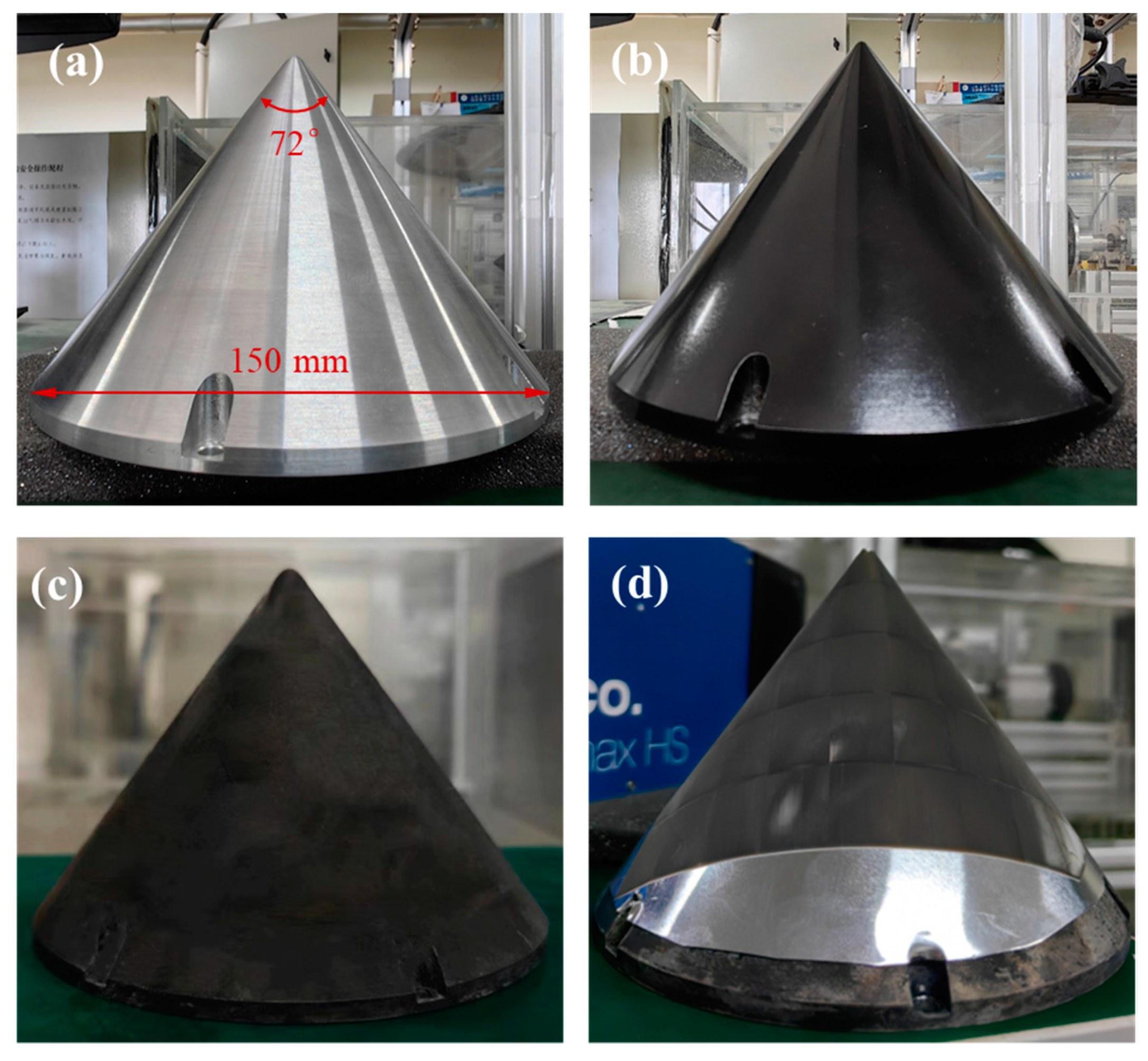

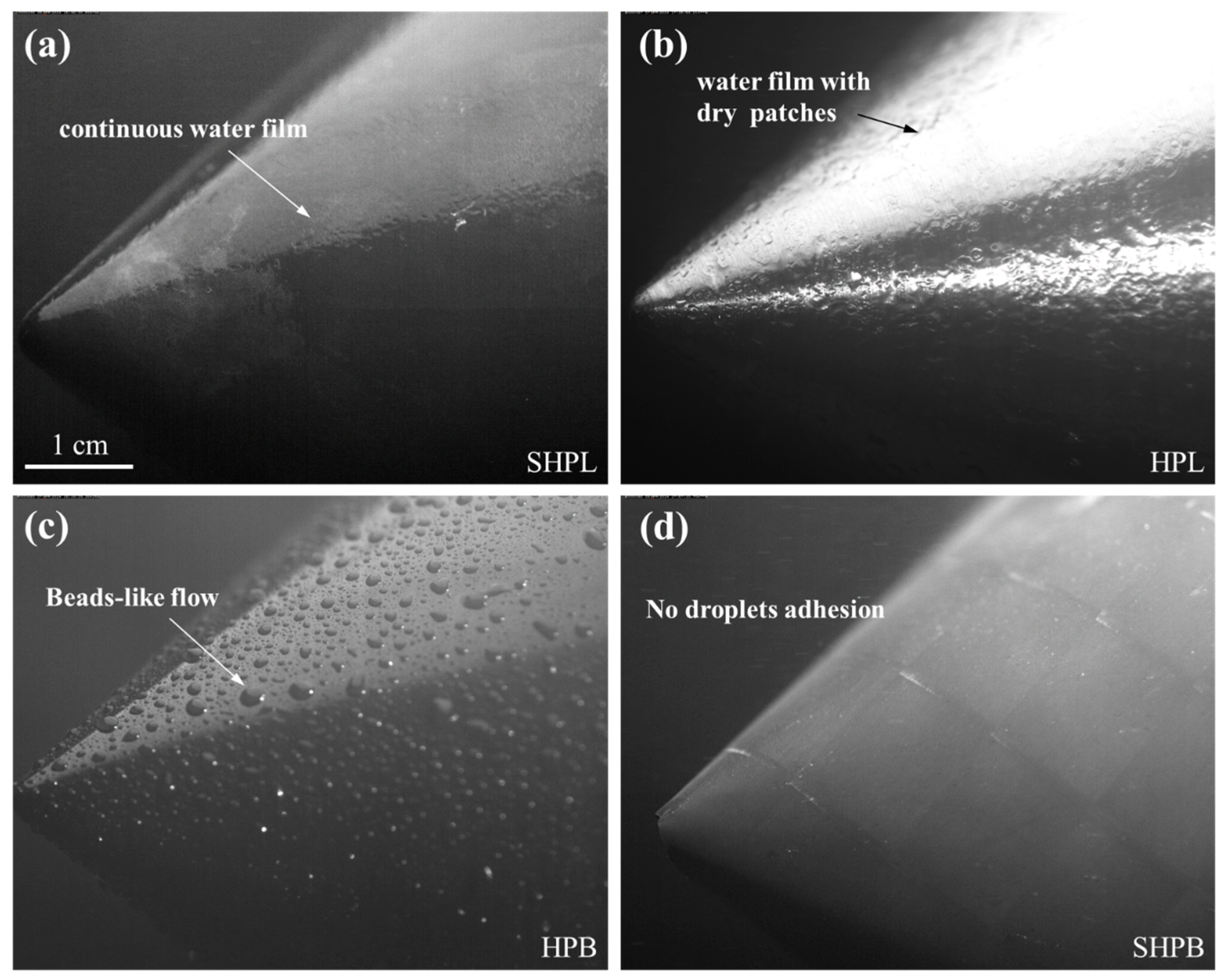

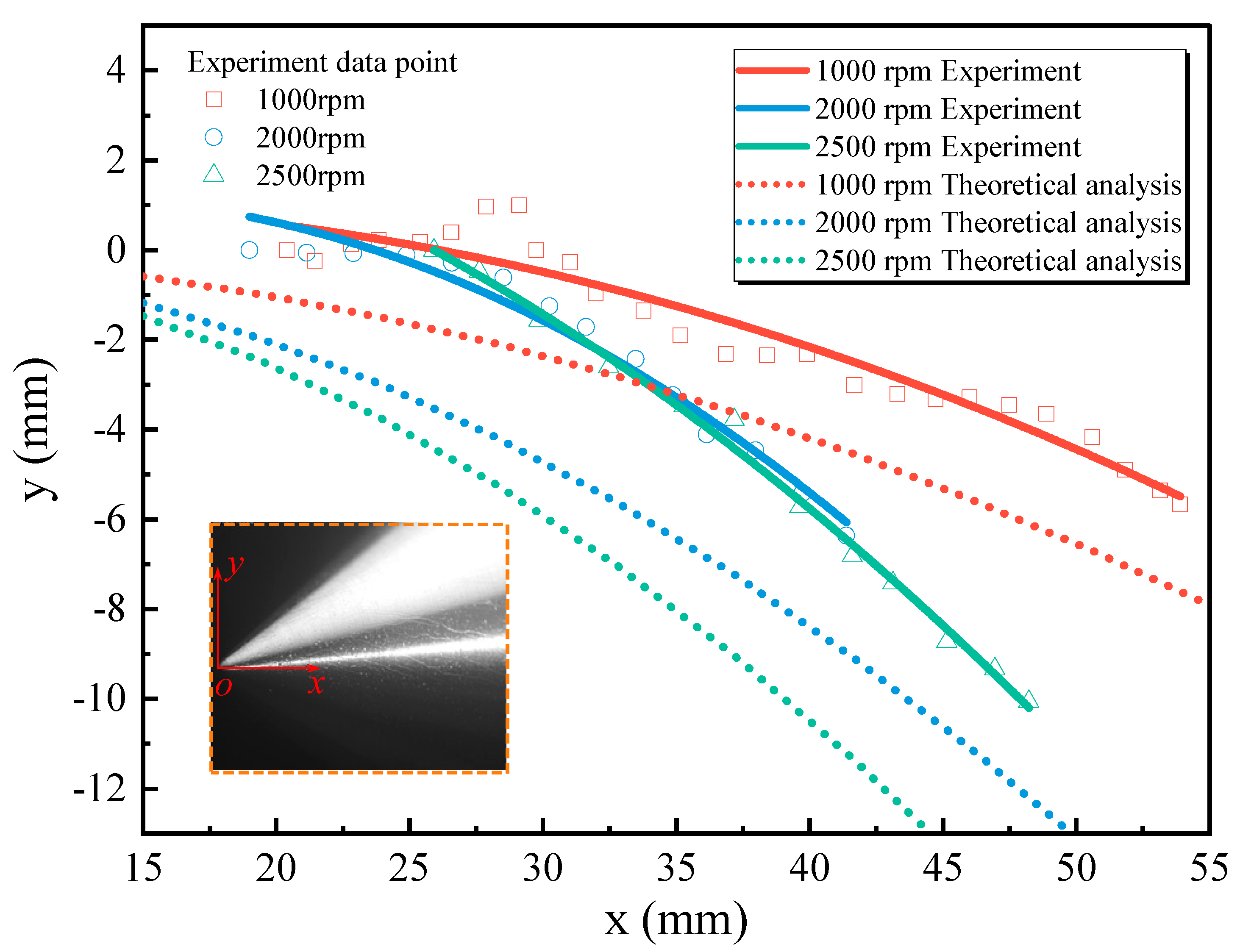
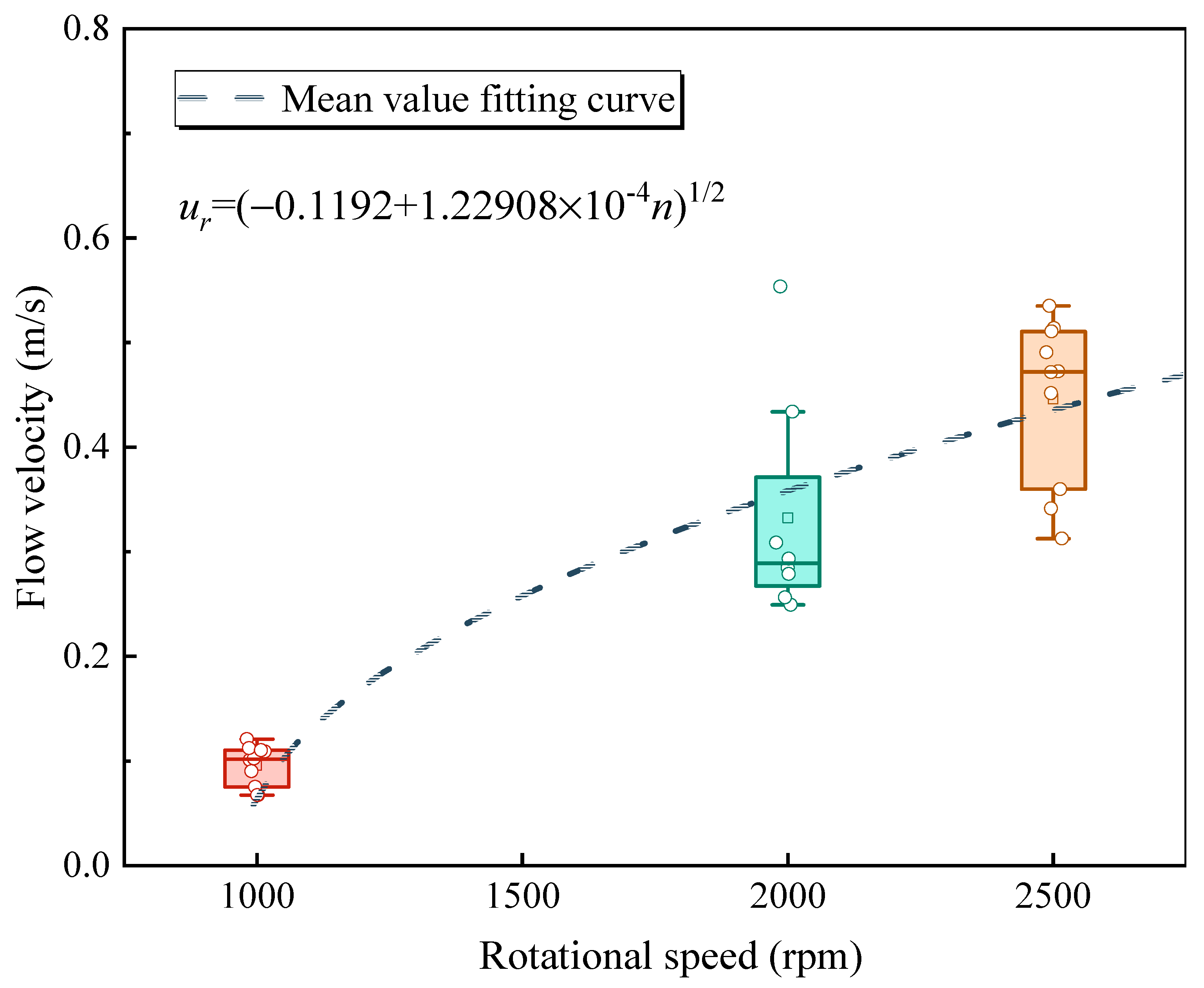

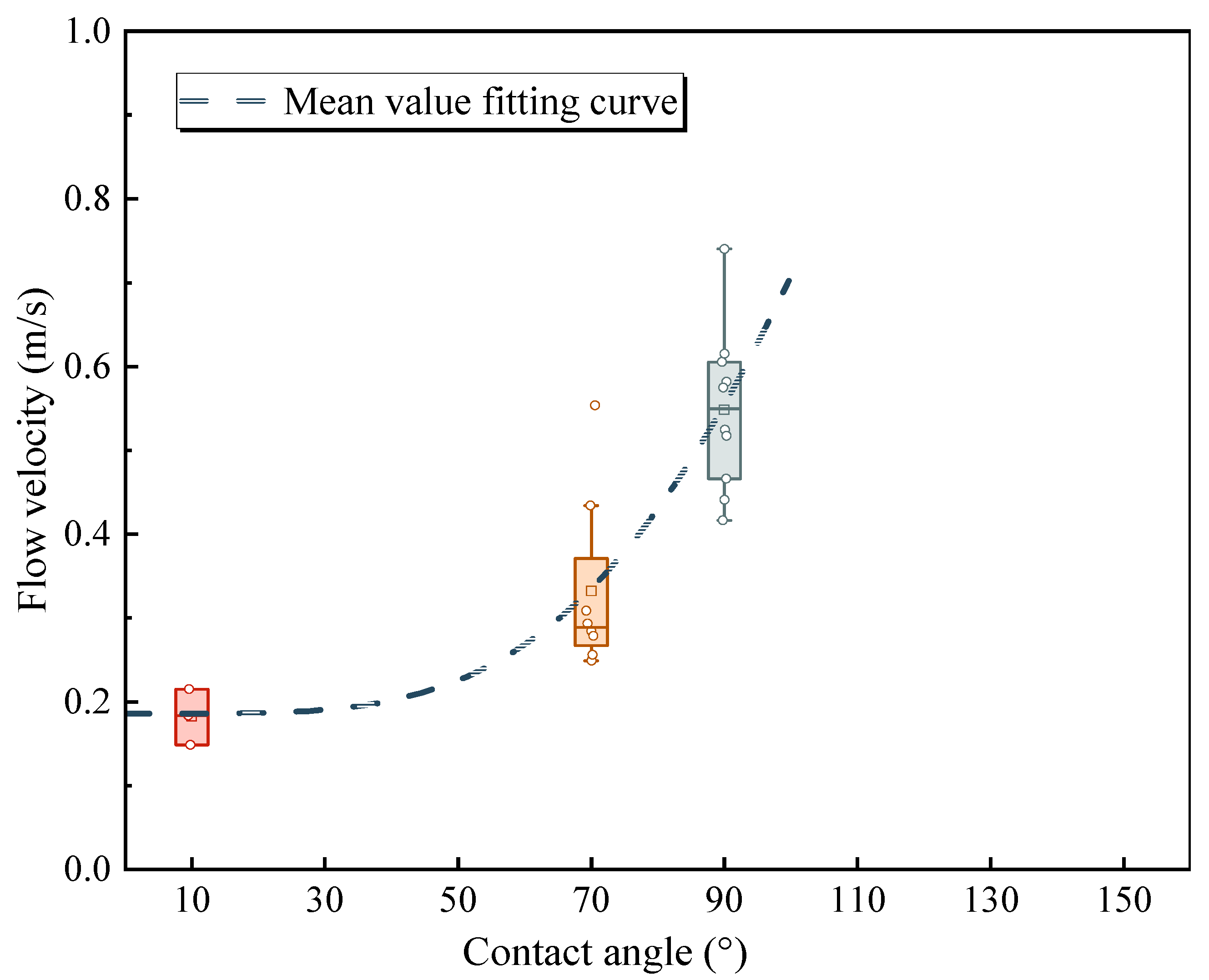
| Surfaces | SHPL | HPL | HPB | SHPB |
|---|---|---|---|---|
| Contact Angle (°) |  |  |  |  |
| 10.2 ± 5 | 71.8 ± 2 | 88.4 ± 2 | 151.3 ± 2 |
| Case No. | Wind Speed (m/s) | LWC (g/m3) | Rotating Speed (rpm) | Surface |
|---|---|---|---|---|
| 1 | 20 ± 1 | 3 ± 0.5 | 0 | HPL |
| 2 | 1000 | HPL | ||
| 3 | 2000 | HPL | ||
| 4 | 2500 | HPL | ||
| 5 | 0 | SHPL | ||
| 6 | 2000 | SHPL | ||
| 7 | 0 | HPB | ||
| 8 | 2000 | HPB | ||
| 9 | 0 | SHPB | ||
| 10 | 2000 | SHPB |
Disclaimer/Publisher’s Note: The statements, opinions and data contained in all publications are solely those of the individual author(s) and contributor(s) and not of MDPI and/or the editor(s). MDPI and/or the editor(s) disclaim responsibility for any injury to people or property resulting from any ideas, methods, instructions or products referred to in the content. |
© 2024 by the authors. Licensee MDPI, Basel, Switzerland. This article is an open access article distributed under the terms and conditions of the Creative Commons Attribution (CC BY) license (https://creativecommons.org/licenses/by/4.0/).
Share and Cite
Ma, K.; Lin, G.; Jin, H.; Shen, X.; Bu, X. Experimental Investigation of Runback Water Flow Behavior on Aero-Engine Rotating Spinners with Different Wettabilities. Aerospace 2024, 11, 591. https://doi.org/10.3390/aerospace11070591
Ma K, Lin G, Jin H, Shen X, Bu X. Experimental Investigation of Runback Water Flow Behavior on Aero-Engine Rotating Spinners with Different Wettabilities. Aerospace. 2024; 11(7):591. https://doi.org/10.3390/aerospace11070591
Chicago/Turabian StyleMa, Kuiyuan, Guiping Lin, Haichuan Jin, Xiaobin Shen, and Xueqin Bu. 2024. "Experimental Investigation of Runback Water Flow Behavior on Aero-Engine Rotating Spinners with Different Wettabilities" Aerospace 11, no. 7: 591. https://doi.org/10.3390/aerospace11070591





